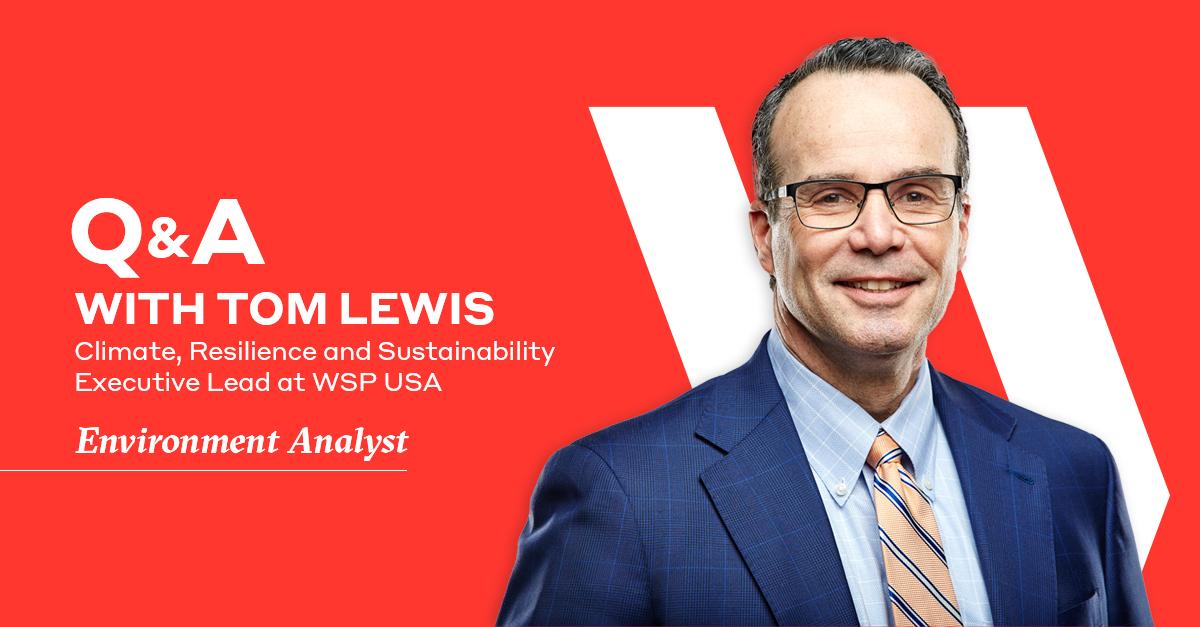EA Global Business Summit 2022: Q&A With Tom Lewis, WSP USA
Environment Analyst caught up with from Tom Lewis, climate, resilience & sustainability executive lead at WSP USA, ahead of his contribution to our global summit in August.

Originally Published by Environmental Analyst
Tom Lewis will be a key participant in a panel discussion on embedding ESG into infrastructure development and project delivery at the Global Business Summit (23-24 August, Denver). Here he offers a preview of his insights.
EA: ESG considerations are forcing change in every business sector. What particular challenges does it present for infrastructure development?
TL: Today’s ESG interests and considerations are not just generically about environment, social and governance per se, but are rather about aligning these three priorities through a climate, sustainability and resilience lens. This means identifying and assessing the climate risks that assets will face across their entire life cycle, and planning and making decisions in a way to make the assets sustainable and resilient in the face of those risks. One of the biggest challenges when it comes to infrastructure development is integrating these considerations into programme and project development activities from the very beginning — including initial project selection, scoping and funding decisions. This is much more frequently achieved for the "E" and the "G" than it is for the "S." In many cases, already under-served communities are further burdened by infrastructure choices focused on least cost. We need to do better, and ensure that when we make our infrastructure more sustainable and resilient this pattern is not repeated.
EA: What about the opportunities: can ESG make infrastructure projects more investable? If so, how?
TL: Taking an ESG-centred approach includes proactively managing financial, social and compliance risks, and will always make a project or asset more investable (and typically more profitable) in the end. The two ESG-related elements most directly linked with financial risks are those related to climate change (eg. losses, damages, downtime costs, social impacts) and environment (eg. managing pollution, environmental impacts and justice, regulatory compliance). Typically, resistance to making infrastructure more sustainable and resilient is based on the false choice that [this] will make it more costly. This is partly because of a bias toward "first costs," or capital expenditures, over "life cycle costs" that also include long-term operations, maintenance and post-useful-life costs. This bias is further exacerbated in many cases by the failure to account for the discounted future cost of risk. Proper risk management and cost discounting can quantify these costs and properly add them to the first costs for the less sustainable and resilient options, improving the quality of project selection.
EA: To what extent are policy and legislation starting to drive ESG practice (in particular in the US, given Biden’s latest pronouncements)? How do these factors sit alongside financial drivers?
TL: Even before the Biden administration and recent legislation and proposed rulemaking occurred in the US, progressive private sector organisations electing to undertake voluntary disclosure of climate-related financial risks and other ESG factors sent signals to the broader marketplace — including investors — that these issues are important for organisational decision-makers, employees and investors of all types from the business case perspective. This in turn helps drive more consistent understanding of ESG risks over time (although today that understanding is still quite inconsistent and messy). Many progressive private investors have been sending this message for several years now based on financial factors. These elements are also reflective of a changing regulatory landscape in response to investor needs and generational shifts in personal attitudes and priorities when it comes to ESG and sustainability. The recent legislation, policies, funding and pronouncements coming out of Washington DC only serve to further drive and inform investor, organisational and individual judgements.
EA: Infrastructure projects invariably have some level of detrimental impact on the environment. How is this reconciled with social and financial gains?
TL: Historically, this may have been generally true, although not universally so — such as in the net long-term environmental impacts of projects involving nature-based solutions (eg. creating living breakwaters with new oyster beds). It certainly does not always have to be true going forward, especially where the incorporation of nature-positive infrastructure, such as using public spaces for stormwater management, biodiversity and flood and heat resilience, can have win/win/win effects. Even hard infrastructure projects can have very high sustainability ratings. The recent LaGuardia Airport expansion project, for instance, for which WSP provided a range of environmental and engineering services, received an ENVISION Platinum rating from the Institute for Sustainable Infrastructure for its high levels of sustainability, resilience and community engagement.
EA: To what extent does social equity influence the process of embedding ESG in an infrastructure project? Is it a complicating or complementary factor?
When handled properly in developing "the right project" it is definitely complementary, and critically important. Infrastructure that doesn’t take into account social equity issues raises the potential for the wrong short-term and/or long-term outcomes that can literally divide and further disadvantage already-overburdened communities. For example, there is a history in the US of roads, highways, airports and waste facilities being built and developed in a way that separates and degrades the health and well-being of traditionally minority/low-income areas, resulting in and exacerbating economic inequality and quality of life issues such as access to health care, cool spaces, food (especially fresh produce and other non-processed foods), public transportation and job centres.
When handled improperly, and pursuing the "wrong project," where the selected location and scope is already baked in before community engagement occurs and input is fully considered, it absolutely becomes a complicating factor. In extreme cases, neglecting to consider social justice impacts can even kill a project after large amounts of time and money have been spent, and with nothing to show.
EA: How are sustainability metrics chosen for planning and managing ESG in the context of infrastructure projects?
TL: Unfortunately, there is not a single, mandated or consensus approach. According to a white paper published in 2021 by the International Coalition for Sustainable Infrastructure (ICSI), of which I am a founding board member and an editorial reviewer, there are many dozens of different reporting and rating frameworks, evaluation tools, standards and guidance documents available at the national and international level. Three better known global examples are the United Nations Sustainable Development Goals (SDGs), the Quality Infrastructure Principles from the World Bank, and the Performance Standards from its sister organisation focused on the private sector, the International Finance Corporation. As with any metrics, goals, frameworks and related rating systems and tools, it is not a one-size-fits-all situation and significant expertise is required to understand when, where and how to choose from and apply the different options.
—
Hear more from Tom at Environment Analyst’s Global Business Summit (23-24 August, Denver), where he will be participating in a panel discussion on embedding ESG into infrastructure development and project delivery. Tom will be joined on the panel by Anthony Kane, President & CEO, Institute for Sustainable Infrastructure (ISI), and other industry leaders.

